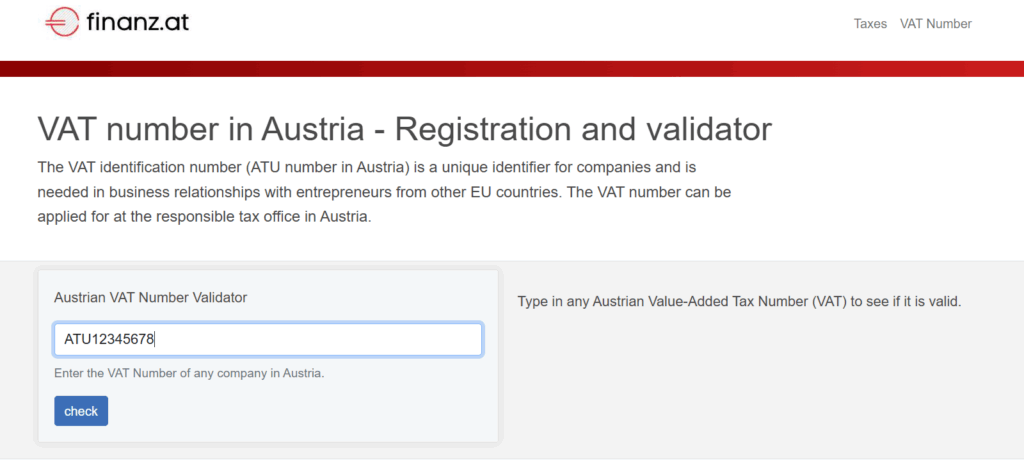VAT ID Verification in Austria: Step-by-Step Process to Check a VAT ID Number Online
In Austria, VAT ID verification is an essential step for businesses trading within the EU. Using an invalid VAT ID can result in rejected invoices, delayed cross-border transactions, or even financial penalties.
To stay compliant, companies should carry out a VAT ID check before finalizing transactions. To verify a number, businesses can use the European Commission’s VIES (VAT Information Exchange System) or directly check with Austria’s Federal Ministry of Finance (Bundesministerium für Finanzen).
Confirming your Austrian UID ensures your business is properly registered and recognized across EU member states.
What Is a VAT ID in Austria?
In Austria, a VAT ID (known as Umsatzsteuer-Identifikationsnummer or UID) is a unique tax identifier issued by the Federal Ministry of Finance to businesses registered for Value Added Tax. This number is required for companies and sole traders that engage in taxable supplies, intra-EU transactions, or cross-border services.
VAT ID appears on invoices, VAT returns, and official correspondence with the Austrian tax authorities. For businesses trading within the EU, keeping the UID valid and active is crucial.
Regular VAT ID verification helps ensure that your number is recognized across member states and avoids issues such as rejected invoices or blocked input tax claims. Performing a VAT ID status lookup through the EU’s VIES system or Austrian tax portals allows companies to confirm registration details and maintain compliance with local and EU VAT regulations.
Importance of the VAT ID for Businesses & Individuals
For companies operating in Austria, holding a valid VAT ID (UID) is central to compliance with national and EU tax rules. A VAT ID is required to issue proper invoices, file VAT returns, and trade across borders.
Regular VAT ID verification helps businesses avoid issues such as rejected input tax deductions or complications in intra-EU transactions. Businesses can verify VAT ID online either through Austria’s Federal Ministry of Finance portal or the EU’s VIES system. This ensures that the UID is active, correctly registered, and recognized by trading partners.
Failure to maintain compliance carries significant consequences in Austria. Ignoring deadlines or submitting VAT irregularities can lead to significant consequences. For individuals and businesses alike, staying current with VAT deadlines and ensuring the VAT ID is valid is crucial to avoiding unnecessary costs and disruptions to operations.
Why Verify a VAT ID in Austria?
VAT ID verification helps you stay compliant with Austria VAT regulations, protect your business from fraudulent activities, and ensure that you can claim VAT refunds and other tax credits without issues.
Consequences of Using an Invalid VAT ID
Using an incorrect or unverified VAT ID can have serious consequences, which are:
- Fines: An invalid VAT ID can lead to penalties and fines from local tax authorities, especially if it’s used on official documents or in tax returns.
- Late filing of VAT returns can incur a penalty of up to 10% of the VAT due
- If payment is also delayed, an additional 2% charge applies, followed by further surcharges of 1% after three months, and yet another 1% if the obligation remains unpaid
- Repeated or serious non-compliance may escalate to audits
- Denied Deductions: A wrong or unverified VAT ID number can result in the denial of valuable tax deductions or credits, such as VAT refunds or R&D tax credits.
- Reputational Damage: If vendors or business partners discover discrepancies in your VAT ID, it can damage your business’s reputation.
Note: Many vendors and business partners implement strict due diligence policies to ensure they’re working with legally compliant businesses. These policies often require businesses to validate VAT ID numbers to confirm that your company is registered.
VAT ID Number Format Explained
In Austria, the VAT Identification Number follows a standardized structure set by the Federal Ministry of Finance. Understanding this format is key for smooth invoicing, compliance, and accurate VAT ID verification, so here’s a breakdown of the key elements:
| VAT ID Type | Format | Explanation |
| VAT Number | ATU + 8 digits (e.g., ATU12345678) | Issued to VAT-registered businesses; “AT” is Austria’s country code, “U” denotes Umsatzsteuer (VAT), followed by 8 unique digits. |
All Austrian VAT IDs (UIDs) follow the same structure as the country doesn’t assign different VAT number formats for branch traders, government departments, or health authorities. Businesses can check their Austria VAT number validity via the EU VIES tool or the Austrian FinanzOnline portal.
Common Typos in VAT ID Numbers
Since all Austrian VAT IDs (UIDs) follow the format ATU + 8 digits, even small errors can cause invoices to be rejected or flagged during audits. Regular VAT ID verification is essential to avoid compliance risks. The most frequent mistakes include:
- Missing Digits: Writing ATU1234578 instead of ATU12345678.
- Incorrect Prefix: Using AT12345678 (missing the “U”) instead of ATU12345678.
- Extra Characters: Adding unnecessary letters or symbols after the UID.
- Wrong Spacing: Inserting spaces (e.g., ATU 1234 5678), which may cause automated systems to reject the entry.
By performing a regular VAT ID lookup in Austria through the FinanzOnline system or the EU VIES portal, businesses can ensure their VAT numbers remain valid and recognized.
Step-by-Step Process to Verify a VAT ID on the Official Austria Portal
In Austria, VAT ID verification is managed by the Federal Ministry of Finance (Bundesministerium für Finanzen, BMF). Businesses can check the validity of an Austrian VAT number (UID) either through the Austrian FinanzOnline system or via the EU-wide VIES database. Using these portals ensures that the VAT ID is valid, registered, and recognized for intra-EU trade.
Here’s a simple step-by-step guide to verify a VAT ID in Austria:
- Visit the Portal: Go to Austria’s FinanzOnline platform or the EU VIES system.
- Enter the UID: Input the Austrian VAT number in the correct format (ATU + 8 digits).
- Submit for Validation: Confirm the entry and click on “check”.

- Check the Result: The system will display whether the VAT ID is active and valid for cross-border transactions.

Troubleshooting Invalid or Inactive Result
During your VAT ID verification, you may encounter error messages indicating that the number is invalid or inactive. Below is a troubleshooting guide to help you resolve common errors and find quick fixes:
| Error Message | Likely Cause | Quick Fix |
| Invalid or Not Recognized | VAT ID is not yet registered with the local tax authority or is incorrect. | Double-check the VAT ID for errors or re-enter it. |
| Inactive ID | VAT ID may have been newly issued or deactivated. | Allow time for processing or confirm activation with the local tax authority. |
| No Record Found | VAT ID not linked to any active account or business. | Verify with the local tax authority or ensure the business is correctly registered. |
| Mismatch with Records | VAT ID does not match the details in the database. | Confirm the details submitted (name, address, etc.) are correct. |
The Role of Licensed Tax Agents in VAT ID Registration & Verification
In Austria, engaging a licensed tax agent (e.g., a Steuerberater or authorized tax consultant) can make a significant difference when tackling VAT obligations. These professionals guide businesses, especially non-resident and cross-border ones, through the process of obtaining UID numbers, handling VAT ID verification, and managing VAT registration. They also liaise directly with the Austrian tax authorities, file VAT returns, and resolve any discrepancies efficiently.
For companies without an Austrian presence, appointing a fiscal representative (often a qualified tax advisor) is mandatory. These experts serve as your local point of contact, ensuring accurate compliance with all VAT procedures and regulations.
VAT ID Verification in Vienna: Why It Matters for Local Businesses
For companies in Vienna, Austria, VAT ID verification is essential to avoid compliance issues and ensure smooth cross-border trade. Many local suppliers rely on it to apply zero-rated VAT on intra-EU sales, especially when exporting goods through Vienna’s logistics hubs and Schwechat Airport.
Verified VAT IDs also protect service providers, such as consultants and agencies, when applying the reverse-charge mechanism for EU clients. Austrian regulators require businesses to keep records of all VAT ID checks through FinanzOnline, which serves as audit evidence.
For Vienna businesses, consistent verification safeguards against rejected invoices, tax penalties, and delays in regional or EU transactions.
Bulk & Automated VAT ID Validation
Manually verifying VAT IDs can be slow and error-prone, especially for businesses handling large volumes. Commenda simplifies the process through automated VAT ID verification using CSV uploads and a powerful Bulk VAT ID validation API.
Instead of checking each VAT number individually, Commenda’s API enables real-time VAT ID verification of hundreds or thousands of records within seconds. Additionally, Commenda supports Austria tax registration number check, allowing businesses to verify VAT numbers along with other tax registration details seamlessly.
Commenda offers a simple API for seamless VAT ID check integration into your system and delivers 99.9% uptime for uninterrupted VAT ID verification.
Explore all features with a 14-day free trial and see how Commenda’s Bulk VAT ID validation API and CSV upload options can simplify your VAT ID check.
Conclusion: Austria VAT ID Verification Made Simple
For companies trading within Austria and across the EU, VAT compliance is more than a box to tick; it’s essential for avoiding penalties and maintaining smooth operations. Accurate VAT ID verification is a critical part of this process, especially given Austria’s reliance on the FinanzOnline system and the EU’s VIES database for cross-border checks.
Commenda streamlines compliance by combining ongoing VAT ID verification with broader tax management tools. Whether through bulk CSV uploads or real-time validation via our API, businesses can process thousands of Austrian and EU VAT numbers in seconds, reducing errors and saving valuable time.
Beyond verification, Commenda supports Austrian VAT returns, record-keeping, and audit readiness, helping finance teams stay fully compliant with local and EU rules. Ready to simplify compliance in Austria? Book a free demo and see how Commenda makes VAT ID verification effortless.
FAQs on VAT ID Verification in Austria
Q. What is a VAT ID in Austria, and how is it different from a tax registration certificate?
A VAT ID in Austria is called the Umsatzsteuer-Identifikationsnummer (UID). It is distinct from a general tax number (Steuernummer), which identifies a taxpayer for all types of taxes.
Q. Why should I verify a VAT ID online before issuing an invoice or purchase order?
Verifying ensures that your business partner is registered for VAT and eligible for cross-border transactions without extra tax liabilities. It also protects you from input tax deduction rejections during audits.
Q. What penalties can my business face for quoting an invalid or inactive VAT ID on tax returns in Austria?
Using incorrect or inactive VAT IDs can lead to denied input-tax deductions, penalties, and interest on unpaid VAT. In serious cases, it can trigger tax audits or fines from the Austrian Ministry of Finance.
Q. How do I check the real-time status of a VAT ID on the official Austria government portal?
The Austrian Ministry of Finance offers the UID-BMF verification tool online. You can enter the UID to confirm validity and obtain a confirmation note for your records.
Q. Can I still claim input-tax credit / VAT refund if my supplier’s VAT ID is later cancelled?
Yes, as long as the VAT ID was valid at the time of the transaction and proper invoices were issued. However, proof of validity at the transaction date is essential.
Q. How long does it take for a newly issued VAT ID to appear as “active” in the online lookup tool?
It usually takes a few days for a newly assigned UID to appear as active in the database. In some cases, delays may occur if registration documents are under review.
Q. What common errors cause a “No records found” result when I try to validate a VAT ID?
The most common issues include incorrect formatting (UIDs must start with “ATU” followed by eight digits), expired IDs, or entering a tax number instead of a VAT ID.
Q. Is there a free API or bulk CSV upload option to bulk-verify VAT IDs for hundreds of vendors at once?
The official BMF portal allows single lookups only. For bulk checks, businesses use third-party providers like Commenda, which offers a Bulk VAT ID validation API and CSV upload functionality.
Q. How often should finance teams re-check supplier VAT ID numbers to stay compliant with Austria regulations?
Best practice is to re-verify VAT IDs at least annually, or whenever there are changes in supplier relationships, to avoid compliance risks.
Q. Does the official Austria VAT ID verification portal provide historical data on status changes (e.g., “active” to “suspended”)?
No, the portal only reflects the current status. For tracking history, businesses rely on internal compliance records or third-party services.
Q. What data privacy safeguards apply when I submit a VAT ID lookup through third-party services like Commenda?
Commenda uses secure, GDPR-compliant systems to process VAT IDs. Data is encrypted during transfer, and no personal identifiers beyond VAT details are stored.
Q. When is it mandatory to engage a licensed tax agent for VAT ID registration or verification in Austria?
Engaging a licensed tax advisor is not mandatory for VAT ID verification. However, foreign businesses often appoint one for VAT registration, filings, and compliance to avoid administrative errors.













